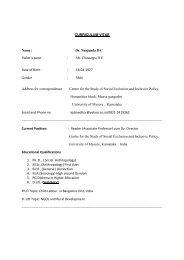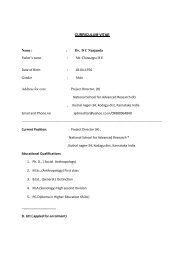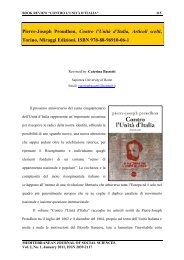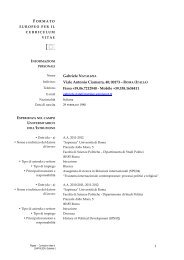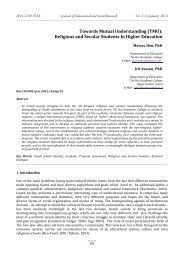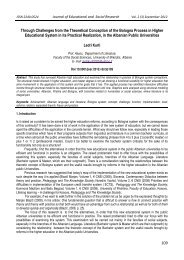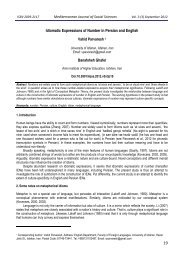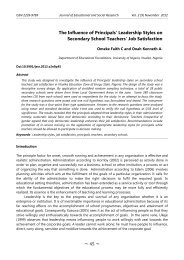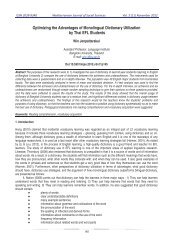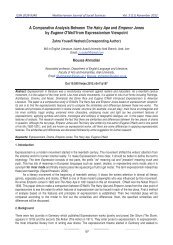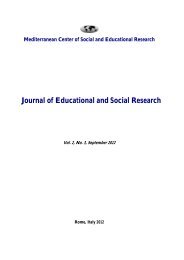383 Edi Festival In Ipetumodu: A Consequent Emotion and Socio ...
383 Edi Festival In Ipetumodu: A Consequent Emotion and Socio ...
383 Edi Festival In Ipetumodu: A Consequent Emotion and Socio ...
Create successful ePaper yourself
Turn your PDF publications into a flip-book with our unique Google optimized e-Paper software.
ISSN 2240‐0524 Journal of Educational <strong>and</strong> Social Research Vol. 2 (2) May 2012<br />
<strong>Edi</strong> <strong>Festival</strong> <strong>In</strong> <strong>Ipetumodu</strong>: A <strong>Consequent</strong> <strong>Emotion</strong> <strong>and</strong> <strong>Socio</strong>-Religious Phenomenon<br />
Prof. Aremu, P. Sholademi Olabisi Ph.D<br />
Department of Fine <strong>and</strong> Applied Arts<br />
Obafemi Awoowo University<br />
Ile-Ife, Nigeria<br />
Email: psoaremu@yahoo.com<br />
Akintonde Akintunde Moses Ph.D.<br />
Department of <strong>In</strong>dustrial Design<br />
Ladoke Akintola University<br />
Ogbomos�o, Nigeria<br />
Email- tundeakin.tonde@yahoo.com<br />
Ijisakin Olaolu Yemi<br />
Department of Fine <strong>and</strong> Applied Arts<br />
Obafemi Awolowo University<br />
Ile-Ife, Nigeria<br />
Email= ijisakinyo@yahoo.com<br />
Doi:10.5901/jesr.2012.v2n2.<strong>383</strong><br />
Abstract: This paper is based on existing literature <strong>and</strong> field investigation into the Yoruba socio-religious festival. <strong>In</strong>vestigation,<br />
observation, <strong>and</strong> oral interviews were carried out to authenticate the existing oral history of the people in <strong>Ipetumodu</strong>. Notable<br />
people <strong>and</strong> the custodians of the shrine involved in <strong>Edi</strong> festival were interviewed during <strong>and</strong> after the festival. The art objects <strong>and</strong><br />
artifacts were identified. These artifacts (Opa, the iron rods representing Moremi <strong>and</strong> her only son Oluorogbo) are very crucial as<br />
they must be pacified <strong>and</strong> worshipped annually or occasionally to appease the deity – Moremi. Elaborate rites are therefore to be<br />
performed as to infuse spiritual power into them before <strong>and</strong> after use. <strong>Edi</strong> originated from Ile-Ife, the ancestral home of the<br />
Yoruba of South-Western Nigeria. Therefore, the study of <strong>Edi</strong> is of historical significance, <strong>and</strong> could be referred to as one of the<br />
hegemonic festivals in which the rulership of a community periodically projects himself before the citizenry <strong>and</strong> endeavour to<br />
demonstrate the power, greatness <strong>and</strong> sanctity of the regime. <strong>Edi</strong> festival could therefore be referred to as Moremi festival<br />
because the festival involves her worship. Her activities <strong>and</strong> importance in the realm of things in Ile-Ife brought about <strong>Edi</strong> festival<br />
to the town of <strong>Ipetumodu</strong> not far from Ile-Ife but of Oyo extraction.<br />
Keywords: <strong>Edi</strong> festival, socio-religious, Opa, Moremi, deity, celebrations, rituals.<br />
1. <strong>In</strong>troduction<br />
<strong>Ipetumodu</strong> is the headquarters of Ife North Local Government area of Osun State in South West Nigeria. It is<br />
about twelve kilometers from Ile-Ife, <strong>and</strong> bounded in the North by Ede Local Government area, in the South-<br />
West by Ayedade Local Government area, in the South by Ife-South <strong>and</strong> in the East by Ife central local<br />
Government area. The people of <strong>Ipetumodu</strong> are of Oyo extraction, <strong>and</strong> speak Oyo dialect. But various oral<br />
traditions of origin seem to suggest various stages of emigration to the town. One of such claims<br />
contemponeity with Ile-Ife, while another supports the Oyo Yoruba particularly from Ogbomoso. Ogbomoso<br />
town is presently in Oyo State of Nigeria. However, they all agree that the founder of <strong>Ipetumodu</strong> was Akalako<br />
whose descendants are the ruling house.<br />
<strong>383</strong>
ISSN 2240‐0524 Journal of Educational <strong>and</strong> Social Research Vol. 2 (2) May 2012<br />
<strong>Ipetumodu</strong>, better referred to as Ipetu (an abbreviation) is noted for pottery, which served <strong>and</strong> still serving<br />
its people <strong>and</strong> its neighbours. Their pottery works are found in Ile-Ife, Okeigbo, Ifewara, Ifetedo all of which<br />
are very close to Ife culturally. Among the people of Ipetu, as in other Yoruba towns such as Oshogbo,<br />
Ogbomoso, Ikire, Shaki, Iseyin e.t.c., god the creator of heaven <strong>and</strong> earth is conceived of as a distant,<br />
relatively unapproachable deity (Mbiti, 1992). He is deemed to be the last resort, the last court of appeal, he<br />
further adds (Ibid). As in many ethnic groups in black African countries, men <strong>and</strong> women have their own<br />
presiding spirits <strong>and</strong> guilds guided by particular gods <strong>and</strong> goddesses, of such are Sango, god of thunder;<br />
Saponna god of small-pox; Obatala, the arch divinity who was said to be present when God created the<br />
whole universe, etc (Personal communication).<br />
During worship, the various spirits <strong>and</strong> deities being worshipped are appeased to appropriately to enable<br />
the adherents receive favours according to individual dem<strong>and</strong>s. The grooves in the town of <strong>Ipetumodu</strong>, the<br />
societies <strong>and</strong> their religious paraphenalia are clear testimonies to their link with their gods <strong>and</strong> goddesses<br />
<strong>and</strong> most especially to Moremi, an important figure in the oral historical h<strong>and</strong>outs of the Ipetu people. <strong>In</strong><br />
working with the spirit forces, according to Mbiti, (1992), it is important to observe certain controls or<br />
restrictions inform of taboos. These taboos are very relevant <strong>and</strong> crucial in that they are to ensure the ritual<br />
cleanliness before the spirits are approached (personal communication). Most of these spirits, gods <strong>and</strong><br />
goddesses are satisfied in terms of festivals to harness their spiritual power so as to purify <strong>and</strong> cleanse the<br />
town of Ipetu, <strong>and</strong> its inhabitants of malevolent forces.<br />
<strong>Edi</strong> festival is one of those festivals used in Ipetuodu for preventive, curative, protective <strong>and</strong> productive<br />
purposes. This is made possible in part by the art <strong>and</strong> artifacts used in the proclamation during the festivities.<br />
Artistic displays carry the sacred power to bring spiritual things into existence, <strong>and</strong> festival is a fundamental<br />
concept of life-force that exists in may forms <strong>and</strong> manifestations <strong>and</strong> in varying amounts at the foundation of<br />
Yoruba philosophy <strong>and</strong> social organization. Dopamu (2004) confirms that festivals are institutionalized<br />
aspects of people’s culture. He further adds that they are aspects of social relationship which continue from<br />
time to time to play important roles in the society. Asare Poku in Dopamu (2004) defines festivals as rituals<br />
which recur at regular intervals <strong>and</strong> which have as their purpose the expression of beliefs held by a particular<br />
community.<br />
The great deities of the town such as Obatala, Oluorogbo Ilase, Olokun, Ogun, Moremi <strong>and</strong> others are still<br />
being worshipped in festivals. Among such festivals are Olokun <strong>and</strong> <strong>Edi</strong> the last of which is held annually to<br />
commemorate a courageous woman called Moremi. Moremi was a very beautiful woman, supposedly the<br />
wife of King Oranmiyan, who was later inherited by Alayemore when he succeeded to the throne after<br />
Oranmiya’s death (Fabunmi, 1969). Moremi was a great patriot who put her life on line to save the people of<br />
Ile-Ife (the place where <strong>Edi</strong> festival originated) from the incessant raids of an outside group, the “Igbos”.<br />
Early in the history of Ile-Ife the Igbos used to frighten its people in the dress of knitted raffia palm threads<br />
that covered their heads, faces <strong>and</strong> feet to give them the appearance of spirits. Accordingly to Ife oral history,<br />
it was customarily necessary for the Igbo to visit Ojafe, a market in Ile-Ife, annually for the worshipping of<br />
their deities known as Aje, Kori, Esa-Oja, in the dead of the right (Personal communication). This night<br />
ceremony is called Pokulere <strong>and</strong> is annually observed on the third day after Ekuru-Itapa ceremony. The<br />
Igbos yearly visit to Ile-Ife was not to capture the Ife people as accepted by uninformed historians. They only<br />
planned to organize themselves into ever growing community with the intention of avenging themselves on<br />
the Ife people who used to spy on them during their night ceremony (Pokulere). The Igbo warriors in raffia<br />
dresses were called Oluyare. One of such people deeply concerend was Moremi, a native of Offa. She then<br />
allowed herself to be captured by the Igbo <strong>and</strong> taken as a war booty to Igbo homestead. The king of the<br />
Igbos married her being very beautiful. It was here that she discovered the secret behind the Igbo’s annual<br />
success in war against her people. She then left the Igbo palace. Because of her promise she made to the<br />
spirit of Esinminrin stream in Ile-Ife that if she was successful in her bid, she would sacrifice whatever would<br />
first come out of her house to embrace her on her return from the Igbol<strong>and</strong>. Unfortunately, her only son<br />
Ela/Oluorogbo was the one to meet <strong>and</strong> embrace her. Her son was sacrificed to the spirit of Esinminrin<br />
384
ISSN 2240‐0524 Journal of Educational <strong>and</strong> Social Research Vol. 2 (2) May 2012<br />
stream. Because of this gallant behaviour, she has since then been referred to as Yeye Aiye Gbogbo – The<br />
Mother of all universe. It was this concept that the people of <strong>Ipetumodu</strong> took to their town, <strong>and</strong> Moremi was<br />
<strong>and</strong> still being worshipped in festival called <strong>Edi</strong>, as it was in Ife, its birth place. The study of <strong>Edi</strong> is therefore of<br />
historical significance. <strong>Festival</strong>s in Ogunba (1991)’s submission st<strong>and</strong> out as sources of Yoruba cultural<br />
history.<br />
2. Background to <strong>Edi</strong> <strong>Festival</strong> in <strong>Ipetumodu</strong><br />
According to the introduction, the traditional origin of <strong>Edi</strong> festival in <strong>Ipetumodu</strong> can always be traced to Ile-Ife,<br />
the cradle of the Yoruba race. The history of the origin is almost lost to legend <strong>and</strong> myths. According to Apetu<br />
of <strong>Ipetumodu</strong> (the traditional king of the town), Moremi was a woman of great beauty <strong>and</strong> courage, a great<br />
warrior <strong>and</strong> a heroine of Offa origin (Personal communication) who sacrificed her only son to Esinminrin<br />
stream. Thus the origin of <strong>Edi</strong> festival in commemoration of Moremi in Ile-Ife <strong>and</strong> its environs, the concept<br />
that spread to <strong>Ipetumodu</strong> (her northern neighbour), Ifewara, Ifetedo, <strong>and</strong> Okeigbo. It is one of the most<br />
important events in these towns. <strong>In</strong> <strong>Ipetumodu</strong> it is usually led by the king <strong>and</strong> his chief-priest – The Apena of<br />
<strong>Ipetumodu</strong>. <strong>Edi</strong> festival in <strong>Ipetumodu</strong> is an annual event which brings sons <strong>and</strong> daughters together in joyous<br />
reunion.<br />
3. Fixing the Date<br />
Dopamu (2004) submits that throughout the world, there are occasions when people come together to<br />
celebrate important events in their lives. The celebration of such events, he further adds is known as festival<br />
<strong>and</strong> it is usually the concern of the whole community (Ibid).<br />
<strong>Festival</strong> date was fixed through Ifa divination; prayers <strong>and</strong> salutations were said by the Apena of<br />
<strong>Ipetumodu</strong>, <strong>and</strong> the chosen date by the diviner <strong>and</strong> the chief priest was rectified by the king, the Oba of<br />
<strong>Ipetumodu</strong> <strong>and</strong> the heads of the ruling families in a joint meeting. Kolanuts, Obi abata were presented in a<br />
very special way to the symbol of deity, (Moremi) the iron rod, opa. Before the presentation by the chief<br />
priest, some prayers, requests of the people were said <strong>and</strong> directed to the deity, Moremi, Iya gbogbo aiye,<br />
mother of the whole universe viz:<br />
Moremi, Iya gbogbo aiye<br />
Fun wa lowo, fun wa l’omo<br />
Ma se doju tiwa<br />
Je k’aba oju rere re pade<br />
Se ona wa ni rere o o o<br />
Je k’ale s’amodun<br />
Moremi, the mother of the whole universe<br />
Bless us with riches <strong>and</strong> children<br />
Do not put us to shame<br />
Be merciful unto us<br />
May our endeavours be acknowledged<br />
May we live to celebrate next year.<br />
Thereafter, the chief priest spilt the two kolanuts into their separate lobes, he then dipped <strong>and</strong> washed them<br />
in a bowl of clean water. This was for ritual cleansing. The Apena then held the kolanuts between his two<br />
palms <strong>and</strong> then called for the blessing of Moremi on the floor of the shrine. The rod, opa, the symbol of<br />
Moremi is made of iron <strong>and</strong> about three <strong>and</strong> a half feet long <strong>and</strong> covered with elephant skin. It looks like a<br />
walking stick, opa itile�. It has serated marks that look like joints of sugar cane or bamboo stick. The stops are<br />
385
ISSN 2240‐0524 Journal of Educational <strong>and</strong> Social Research Vol. 2 (2) May 2012<br />
there to keep the costume made of strips of cloths in place during the annual <strong>Edi</strong> festival. Rituals were<br />
offered to the opa before strips of cloth were attached unto it. This was a purification act (Personal<br />
communication). All these rituals <strong>and</strong> other religious acts, according to an informants, were in effect, health<br />
rituals since they were aimed at preserving <strong>and</strong> prolonging human life.<br />
4. Costumes <strong>and</strong> their attributes<br />
After the preliminary arrangements had been completed, the chief priest made sure that Moremi costume <strong>and</strong><br />
that of her mythical son, Oluorogbo were put in order <strong>and</strong> ready for use during <strong>Edi</strong> festival. The Opa was<br />
washed with water <strong>and</strong> lime water, omi orombo, before day break. It was after this exercise that the costumes<br />
were attached to iron rods representing Moremi <strong>and</strong> her son Oluorogbo. These costumes were made by the<br />
worshippers with the belief that the spirit of Moemi <strong>and</strong> that of her son live in them.<br />
Moremi costume had headmask at the top of the iron structure (the opa). This head mask was made with<br />
leather. The head has a triangular-shaped-eyes that looked like Yoruba wooden mask. The headmask was<br />
prominent <strong>and</strong> in itself conveyed to any sensitive viewer the power of the costume. The maker of this<br />
costume has technical as well as artistic skills that contribute in a singular way to the making of the<br />
headpiece an essential <strong>and</strong> appropriate focus of the costume. The worshippers regarded the facial features<br />
of the costume as keeping watchful eyes over them, which is a guarantee of ancestral protection. Hence, it is<br />
morally binding that the devotees should obey all the taboos regarding the upkeep of the costumes <strong>and</strong> their<br />
relevance to <strong>Edi</strong> festival (Personal communication).<br />
The costume of Oluorogbo on the other h<strong>and</strong>, looks like that of the eyo masquarades of Lagos. It has a<br />
cap which made it to represent a male figure. The colour red, pupa of the costume does not symbolize any<br />
religious connotation. It has no religious interpretations in the worship of Moremi. But with other deities in<br />
Yorubal<strong>and</strong> as a whole, colour is significantly associated.<br />
It is true that these costumes were built by the people, <strong>and</strong> there are important taboos that must be<br />
religiously obeyed first <strong>and</strong> foremost, the costumes must not be washed, (Just like the egungun<br />
masquerades costumes) because of the spirits <strong>and</strong> medicines applied to them. They must not be burnt <strong>and</strong><br />
the carriers must be virgins. They should not be carried by uninitiated persons <strong>and</strong> palm kernel oil, adi,<br />
should not be allowed to touch the costumes because adi is meant for esu, the spirit of confusion. But among<br />
other people, esu is considered very crucial in that it is the err<strong>and</strong> runner for all other deities. The carriers of<br />
opa should not lie to being a virgin, if she does, it is believed that she will be barren for life. When carrying the<br />
opa during the edi festival, she must not fall down. If barren women approach them during edi festival <strong>and</strong><br />
make necessary offering <strong>and</strong> sacrifice, it is believed that they would be blessed with children, <strong>and</strong> the<br />
children so given are named Abedide, children that come with edi festival. This is reflected in their song viz:<br />
Alari mo dolomo o o o<br />
Alari mo dolomo o o o<br />
Chorus: Opa jowo fun mi ni temi<br />
Moremi jowo ba mi se temi<br />
Opa jowo fun mi ni emi o o o<br />
386<br />
Alari (someone’s name) I have my own child<br />
Opa (costumed figure of Moremi) please give me my own<br />
Moremi please give me my own child<br />
Opa, please give me my own child<br />
This is repeated as many times as possible during <strong>Edi</strong> outing. Celebration of these festivals can be described<br />
as essentially a historical enquiry into the past of the people of <strong>Ipetumodu</strong>. It is characteristically concerned<br />
with socio-religious events.
ISSN 2240‐0524 Journal of Educational <strong>and</strong> Social Research Vol. 2 (2) May 2012<br />
5. <strong>Festival</strong> Proper<br />
The entire edi festival, traditionally takes seven days in <strong>Ipetumodu</strong>, <strong>and</strong> on the decided day, the king, oba, the<br />
Apetu of Ipetu <strong>and</strong> his chiefs <strong>and</strong> other worshippers gathered at the palace ground as early as eight o clock<br />
in the morning to usher in the <strong>Edi</strong> festival. The chief priest who is the sole custodian of the opa, removed it<br />
from the shrine after an initial brief ritual observance. Lime water, omi orombo was used to wash it, this was<br />
to prevent it from rusting. Dopamu (2004) submits that no account of any festival can be complete unless it<br />
includes references to what it means to the people who celebrate it. <strong>Edi</strong> festival has a purpose for the people<br />
of <strong>Ipetumodu</strong>, it has actually conserved <strong>and</strong> sustained <strong>Ipetumodu</strong> <strong>and</strong> its society. Through edi people<br />
express <strong>and</strong> achieve unity. <strong>In</strong> this regard therefore festival, is a religious phenomenon. It is functional to<br />
social cohesion <strong>and</strong> solidarity (Durkheim 1915). Mbiti (1992) is also of the opinion that through festivals the<br />
life of the community is renewed. People are entertained <strong>and</strong> their tensions find an outlet, he further adds. <strong>In</strong><br />
<strong>Ipetumodu</strong> religious <strong>and</strong> social values are repeated <strong>and</strong> renewed through communal festivals such as edi<br />
festival. Moremi festival as edi is popularly referred to, functions more on a communal than individual basis<br />
because its celebration involves the entire community, <strong>and</strong> its beliefs are held by the community.<br />
It is sad to note that presently situations have changed, most people went about their daily work without<br />
any special interest in the festival, this was brought about because of foreign religions Christianity <strong>and</strong><br />
Moslem. The first day of the festival according to the traditional history of the people, was the royal display of<br />
“br<strong>and</strong>” by the king, the Apetu of <strong>Ipetumodu</strong> during which the king took a smouldering firewood for a display<br />
en route sectors of the town, dancing <strong>and</strong> singing as follows.<br />
Agbagba lai se’lu o o o<br />
Kaye ma baje o o o (3ce)<br />
Chorus: Agbagba lai se’lu o o o<br />
Kaye ma baje o o o o (3ce)<br />
The town (<strong>Ipetumodu</strong>) was made of elders<br />
May the world not get bad/spoilt<br />
Chorus: The town (<strong>Ipetumodu</strong>) was made of elders<br />
May the world not get bad/spoilt.<br />
The song was repeated many times during the parade. Singing <strong>and</strong> dancing by the king <strong>and</strong> other<br />
worshippers created a joyous <strong>and</strong> tumultuous impression <strong>and</strong> provided a fitting climax to the entire festival.<br />
Parading of the staffs of Moremi <strong>and</strong> her only son Oluorogbo round the town ended the first day of the<br />
festival. Pounded yam, Iyan used to be the favourite food of Moremi, because of this reason the whole<br />
community prepared her favourite food, iyan for public consumption at the market place <strong>and</strong> the king’s<br />
palace. During this time, association with team work was necessary as the festival called for collective<br />
discharge of duties most especially in the preparation of food. Cooking activities were carried out by different<br />
groups in the community. It was discovered that their religious practices such as worship <strong>and</strong> initiation<br />
ceremony to include festival, according to Fortes, (1962) function more on communal than on individual<br />
basis. From all indications the Yoruba people generally place a high premium on the spiritual development of<br />
every member of the society, probably this is why <strong>Edi</strong> festival is always taken as an important <strong>and</strong> crucial<br />
aspect of human activities in the town.<br />
On the second day of the festival, the king did not go out to meet the people, but the people went about<br />
with their merriment singing <strong>and</strong> dancing viz:<br />
1. Moremi jowo fun mi l’omo temi<br />
Chorus: Moremi jowo fun mi l’omo mi<br />
Fun mi lo�mo� mi (2ce)<br />
2. Moremi jowo bami lofo lo�<br />
387
ISSN 2240‐0524 Journal of Educational <strong>and</strong> Social Research Vol. 2 (2) May 2012<br />
388<br />
Chorus: Moremi jowo ba mi lofo lo o o o<br />
Bami lofo lo (2ce)<br />
3. Eni pe n ku sobiya a daa<br />
Chorus: Eni pe n ku sobiya a daa o o o<br />
E�ni pe n ku o ni ku re<br />
Eni pe n ku ko ni ku re o o o<br />
1. Moremi please give me my own child<br />
Chorus: Moremi please give me my child<br />
Give me my child (2ce)<br />
2. Moremi please help me drive away poverty<br />
Chorus: Help me to drive poverty away<br />
Drive away poverty (2ce)<br />
3. Anybody who wishes me dead<br />
Will be attacked by guinea worm<br />
Chorus: Anybody who wishes me dead<br />
Will be attacked by guinea worm<br />
Anybody who wishes me dead<br />
Will not die a peaceful death<br />
The ceremony continued like this throughout the period of the festival which was characterized by feasting,<br />
merry-making, offering of sacrifices singing <strong>and</strong> whipping of Ongo. Ongo whipping was done by young boys<br />
in their teens. They were seen at the market place. Ongo is carved in soft white wood of various sizes <strong>and</strong><br />
shapes, painted in different beautiful colours. The bottom of Ongo is always round to allow for easy spinning.<br />
People gathered to watch young boys demonstrating their skills. Ongo tradition has being in existence since<br />
the inception of <strong>Edi</strong> festival in <strong>Ipetumodu</strong> (personal communication).<br />
The third, forth, fifth <strong>and</strong> the sixth day of the festival are referred to as Ojo Iwode Moremi, the day when<br />
worshippers went round the town visiting chiefs, the king <strong>and</strong> family members as well as eminent people in<br />
the town. The king – The Apetu of <strong>Ipetumodu</strong> <strong>and</strong> his chiefs were at the palace ground watching the<br />
ceremonies. Moremi represents protective <strong>and</strong> preventive forces <strong>and</strong> is therefore very popular among the<br />
people, <strong>and</strong> her festival is celebrated annually in <strong>Ipetumodu</strong> <strong>and</strong> other towns such as Ife, Ifewara, Ifetedo,<br />
Okeigbo <strong>and</strong> among a small community in Ayeye area of Ibadan, capital of Oyo state of Nigeria.<br />
The last day of the festival, was the climax, when the king had to assume full spiritual leadership <strong>and</strong><br />
Moremi’s blessings were sought for the entire community. The king appeared in his full regalia with his<br />
traditional beaded crown – Ade. The crown is the principal symbol of the king’s authority (Sieber <strong>and</strong> Walker,<br />
1988). The true king in Yorubal<strong>and</strong> is distinguished by the right to wear beaded crown. During the festival, the<br />
Apetu represents the founding father of the town Akalako. Akalako was the founding father of the town. The<br />
Apetu represented him by adorning himself with the traditional Are crown passed on to him from Akalako.<br />
This crown has sixteen faces organized in a pattern over the entire crown, with a gathering of birds<br />
surmounted with a bigger one at the top of the crown. <strong>In</strong> most instances of Yoruba ritual art, birds, eiye are<br />
references to the mystical power of women, known affectionately as “awo�n iya, the mother or abusively – the<br />
witches (Drewal <strong>and</strong> Drewal, 1980).<br />
Most kings in Yoruba l<strong>and</strong> rule successfully only with the spiritual support <strong>and</strong> cooperation of Our Mothers,<br />
awon iya wa referring to the witches. They are mostly respected as the powerful ones. Prayers were said <strong>and</strong><br />
directed to Moremi in a manner similar to that of children speaking to their parents about themselves <strong>and</strong><br />
their needs. The people believe that she is merciful <strong>and</strong> kind, <strong>and</strong> she is called the merciful one, one that can<br />
answer their calls always.
ISSN 2240‐0524 Journal of Educational <strong>and</strong> Social Research Vol. 2 (2) May 2012<br />
The last day of the festival was full of religious activities as well. The chief priest spilt two kolanuts for<br />
spiritual cleansing <strong>and</strong> purification. He asked the festival to restore peace, happiness <strong>and</strong> a sense of security<br />
here on earth most especially for the people of <strong>Ipetumodu</strong>. Drums were then beaten at the end of the<br />
celebrations to open another year of expectations from Moremi.<br />
6. Conclusion<br />
<strong>Edi</strong> festival is communal in nature <strong>and</strong> it is better referred to as hegemonic festival, it therefore contributes<br />
largely to the maintenance of continuity <strong>and</strong> stability of communal beliefs <strong>and</strong> practices in <strong>Ipetumodu</strong>. From<br />
the above, we have seen that the <strong>Edi</strong> festival means something significant to the people of <strong>Ipetumodu</strong>,<br />
because it preserves tradition, culture <strong>and</strong> socio-religion. <strong>In</strong> like vein, it gives “full <strong>and</strong> eloquent expressions to<br />
religious sentiments <strong>and</strong> beliefs. Supporting this view, Dopamu (2004) submits that Yoruba festivals will<br />
continue to be celebrated <strong>and</strong> they will continue to express man’s relationship to the supernatural <strong>and</strong> to their<br />
fellow human beings.<br />
References<br />
Dopamu, P.A. (2004). Traditional <strong>Festival</strong>s in Underst<strong>and</strong>ing Yoruba Life <strong>and</strong> Culture. Africa would Press <strong>In</strong>c. Trenton, MJ; Asmara,<br />
Entrea.<br />
Drewal, H.J. <strong>and</strong> Drewal, M.T. (1980). Composing Time <strong>and</strong> Space in Yoruba Art. Paper presented at the Conference on the Relation<br />
between Verbal <strong>and</strong> Visual Arts in Africa. Pennyslaviana<br />
Durkheim, E. (1915). The Elementary Forms of Religious Life. London. (English Translation)<br />
Fabumi M.A. (1969). Ife Shrines. Published by the University of Ife Press, Ile-Ife.<br />
Fortes, M. (1962). Marriage <strong>In</strong> Tribal Societies. Cambridge: CUPs<br />
Mbiti, J.S. (1992). <strong>In</strong>troduction to African Religious. 2nd edition (Nairobi: East African Educational Publishers)<br />
Ogunba, O. (1999). Hegemonic <strong>Festival</strong>s in Yorubal<strong>and</strong>. Published by IFE, Annals of the <strong>In</strong>stitute of Cultural Studies, Obafemi Awolowo<br />
University, Ile-Ife.<br />
Personal commincation with M.S. Orosanya at <strong>Ipetumodu</strong> (August 27th 2001).<br />
Personal Communciation with Pa Adedire Joseph at <strong>Ipetumodu</strong> (17th October, 2000).<br />
Personal Communciation with Pa M.S. Orosanya at Ieptu (7th September 2000).<br />
Personal communication with Apetu of <strong>Ipetumodu</strong> at <strong>Ipetumodu</strong> (17th September, 2000).<br />
Personal Communication with Bolaji Adefioye at Ilare area of Ile-Ife. (October 18th 2000).<br />
Personal Communication with Pa Samuel Adedire at <strong>Ipetumodu</strong> (October 18th 2000)<br />
Sieber, R. <strong>and</strong> Walker A. (1988). African Art in the Circle of Life. Published by Smithsonian <strong>In</strong>stitution. Washington D.C.<br />
389



